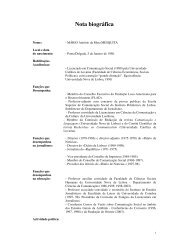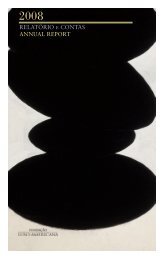A decade later - Fundação Luso-Americana
A decade later - Fundação Luso-Americana
A decade later - Fundação Luso-Americana
You also want an ePaper? Increase the reach of your titles
YUMPU automatically turns print PDFs into web optimized ePapers that Google loves.
‘ The existence of these trees in portugal<br />
is linked to the botanical bent of<br />
the upper crust english who lived<br />
in portugal at the time. The members<br />
of the privileged set were determined<br />
to design gardens containing species<br />
that had been discovered under the<br />
patronage of the British aristocracy.<br />
’<br />
and grooves; with the wood being extremely<br />
similar to that of the acacia, but without<br />
its striations and hardness (…) It is a species<br />
worth propagating on a large scale.” 3<br />
Despite the obvious merits of the tulip tree<br />
(which is native to Indiana, Kentucky, and<br />
Tennessee, and was used by the Indians to<br />
make dug-out canoes) and other American<br />
species like the white magnolia, the black<br />
locust, and the catalpa, which were brought<br />
to Portugal throughout the 17 th , 18 th , and<br />
19 th centuries, they were never used on a<br />
66<br />
cuLTure<br />
wide scale or planted<br />
intensively.<br />
Catalpa-planting fever<br />
first hit the US in 1870,<br />
as the species was both<br />
fast-growing and highly-resistant.<br />
Used by<br />
the Muskogee Indians<br />
(also known as the<br />
Creeks), the catalpa<br />
turned out to be a valuable<br />
resource in making<br />
railroad ties for<br />
America’s expanding<br />
railway network. It was<br />
described in Portugal’s Journal of Practical<br />
Horticulture in the late 1800s, but there is<br />
no mention of any large-scale use anywhere<br />
in the country. Even though<br />
Portugal’s inaugural train trip had taken<br />
place on October 28, 1856, the rural<br />
nature of the country led writers to propose<br />
that the northern catalpa be planted<br />
“together with the eucalyptus,” since this<br />
would “clear up humid terrain, lend variety<br />
to the landscape, and contribute greatly<br />
to the country’s material wealth.” 4<br />
detail of a catalpa blossom, 2006.<br />
To some extent, though unconsciously,<br />
they were becoming tacit accomplices to<br />
the destruction of America’s landscape,<br />
which had fallen prey to burgeoning<br />
industrial growth. Dazzled by the prospective<br />
profitability of these “supertrees,”<br />
these writers never once considered<br />
the impact they would have on the country’s<br />
environment.<br />
In an article from the Journal of Practical<br />
Horticulture of 1896, writer M. de Freitas<br />
starts off by praising the ornamental qualities<br />
of the black locust, a native of the<br />
Appalachian Mountains whose leaves have<br />
an “enchanting effect,” and whose flowers<br />
give off a “mild scent” reminiscent of<br />
“orange blossoms.” He concluded that the<br />
black locust tree warranted planting in the<br />
nation’s “woods,” “avenues,” and “public<br />
parks,” as he had seen done in Paris. After<br />
pondering the issue a bit more, he excitedly<br />
proselytizes that they be planted everywhere:<br />
“Landowners, spurred on by the<br />
guarantee of making a profit, should not<br />
disdain this useful advice, but make it their<br />
business to disseminate everywhere this<br />
tree, which today is the most precious one<br />
Parallel no. 6 | FALL | WINTER 2011
















